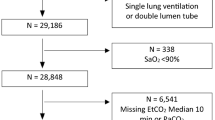Abstract
Various factors including severe obesity or increases in intra-abdominal pressure during laparoscopy can lead to inaccuracies in end‐tidal carbon dioxide (PETCO2) monitoring. The current study prospectively compares ET and transcutaneous (TC) CO2 monitoring in severely obese adolescents and young adults during laparoscopic-assisted bariatric surgery. Carbon dioxide was measured with both ET and TC devices during insufflation and laparoscopic bariatric surgery. The differences between each measure (PETCO2 and TC‐CO2) and the PaCO2 were compared using a non‐paired t test, Fisher’s exact test, and a Bland–Altman analysis. The study cohort included 25 adolescents with a mean body mass index of 50.2 kg/m2 undergoing laparoscopic bariatric surgery. There was no difference in the absolute difference between the TC‐CO2 and PaCO2 (3.2 ± 3.0 mmHg) and the absolute difference between the PETCO2 and PaCO2 (3.7 ± 2.5 mmHg). The bias and precision were 0.3 and 4.3 mmHg for TC monitoring versus PaCO2 and 3.2 and 3.2 mmHg for ET monitoring versus PaCO2. In the young severely obese population both TC and PETCO2 monitoring can be used to effectively estimate PaCO2. The correlation of PaCO2 to TC-CO2 is good, and similar to the correlation of PaCO2 to PETCO2. In this population, both of these non-invasive measures of PaCO2 can be used to monitor ventilation and minimize arterial blood gas sampling.


Similar content being viewed by others
References
Bhavani-Shankar K, Moseley H, Kumar AY, et al. Capnometry and anaesthesia. Can J Anaesth. 1992;39:617–32.
Pansard JL, Cholley B, Devilliers C, et al. Variation in arterial to end-tidal CO2 tension differences during anesthesia in the ‘kidney rest’ lateral decubitus position. Anesth Analg. 1992;75:506–10.
Grenier B, Verchere E, Meslie A, et al. Capnography monitoring during neurosurgery: reliability in relation to various intraoperative positions. Anesth Analg. 1999;88:43–8.
Sivarajan VB, Bohn D. Monitoring of standard hemodynamic parameters: heart rate, systemic blood pressure, atrial pressure, pulse oximetry, and end-tidal CO2. Pediatr Crit Care Med. 2011;12(Suppl):S2–11.
Raemer D, Francis D, Philip JH. Variations in PCO2 between arterial and peak expired gas during anaesthesia. Anesth Analg. 1982;62:1065–9.
Oberg B, Poulsen TD. Obesity: an anaesthetic challenge. Acta Anaesthesiol Scand. 1996;40:191–200.
Nguyen NT, Anderson JT, Budd M, et al. Effects of pneumoperitoneum on intraoperative pulmonary mechanics and gas exchange during laparoscopic gastric bypass. Surg Endosc. 2004;18:64–71.
Tobias JD, Meyer DJ. Noninvasive monitoring of carbon dioxide during respiratory failure in toddlers and infants: end-tidal versus transcutaneous carbon dioxide. Anesth Analg. 1997;85:55–8.
Nosovitch MA, Johnson JO, Tobias JD. Noninvasive intraoperative monitoring of carbon dioxide in children: endtidal versus transcutaneous techniques. Paediatr Anaesth. 2002;12:48–52.
McBride DS, Johnson JO, Tobias JD. Noninvasive carbon dioxide monitoring during neurosurgical procedures in adults: end-tidal versus transcutaneous techniques. South Med J. 2002;95:870–4.
Rithalia SVS, Ng YN, Tinker J. Measurement of transcutaneous PCO2 in critically ill patients. Resuscitation. 1982;10:13–8.
Rithalia SVS, Clutton-Brock TH, Tinker J. Characteristics of transcutaneous carbon dioxide tension monitors in normal adults and critically ill patients. Intensive Care Med. 1984;10:149–53.
Bhavani-Shankar K, Steinbrook RA, Mushlin PS, et al. Transcutaneous PCO2 monitoring during laparoscopic cholecystectomy in pregnancy. Can J Anaesth. 1998;45:164–9.
Janssens JP, Howarth-Frey C, Chevrolet JC, et al. Transcutaneous PCO2 to monitor noninvasive mechanical ventilation in adults. Chest. 1998;113:768–73.
Sanders MH, Kern NE, Costantino JP, et al. Accuracy of end-tidal and transcutaneous PCO2 monitoring during sleep. Chest. 1994;106:472–83.
Evans EN, Ganeshalingam K, Ebden P. Changes in oxygen saturation and transcutaneous carbon dioxide and oxygen levels in patients undergoing fiberoptic bronchoscopy. Respir Med. 1998;92:739–42.
Phan CQ, Tremper KK, Lee SE, et al. Noninvasive monitoring of carbon dioxide: a comparison of the partial pressure of transcutaneous and end-tidal carbon dioxide with the partial pressure of arterial carbon dioxide. J Clin Monit. 1987;3:149–54.
Miller DR, Hull KA, Baines J, et al. A comparison of transcutaneous, end-tidal and arterial measurements of carbon dioxide during general anaesthesia. Can J Anaesth. 1992;39:31–6.
Bendjelid K, Schutz N, Stotz M, et al. Transcutaneous PCO2 monitoring in critically ill adults: clinical evaluation of a new sensor. Crit Care Med. 2005;33:2203–6.
Parker SM, Gibson GJ. Evaluation of a transcutaneous carbon dioxide monitor (“TOSCA”) in adult patients in routine respiratory practice. Respir Med. 2007;101:261–4.
McEvedy BA, McLeod ME, Mulera M, et al. End-tidal, transcutaneous and arterial PCO2 measurements in critically ill neonates: a comparative study. Anesthesiology. 1988;69:112–6.
Bernet-Buettiker V, Ugarte MJ, Frey B, et al. Evaluation of a new combined transcutaneous measurement of PCO2/pulse oximetry oxygen saturation ear sensor in newborn patients. Pediatrics. 2005;115:64–8.
Griffin J, Terry BE, Burton RK, et al. Comparison of end-tidal and transcutaneous measures of carbon dioxide during general anaesthesia in severely obese adults. Br J Anaesth. 2003;91:498–501.
Maniscalco M, Zedda A, Faraone S, et al. Evaluation of a transcutaneous carbon dioxide monitor in severe obesity. Intensive Care Med. 2008;34:1340–4.
Ethical standards
This study complies with the current ethical laws in the United States.
Conflict of interest
The authors declare that they have no conflict of interest.
Author information
Authors and Affiliations
Corresponding author
Rights and permissions
About this article
Cite this article
Dion, J.M., McKee, C., Tobias, J.D. et al. Carbon dioxide monitoring during laparoscopic-assisted bariatric surgery in severely obese patients: transcutaneous versus end-tidal techniques. J Clin Monit Comput 29, 183–186 (2015). https://doi.org/10.1007/s10877-014-9587-1
Received:
Accepted:
Published:
Issue Date:
DOI: https://doi.org/10.1007/s10877-014-9587-1




